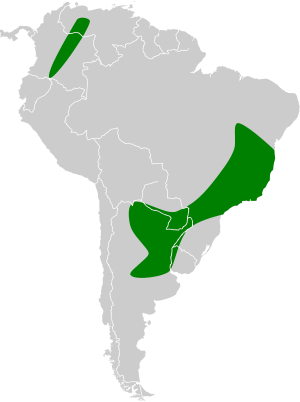Diminutive serotine facts for kids
Quick facts for kids Diminutive serotine |
|
|---|---|
 |
|
| A diminutive serotine bat being held as part of a survey in Brasil | |
| Conservation status | |
| Scientific classification | |
| Genus: |
Eptesicus
|
| Species: |
diminutus
|
 |
|
The diminutive serotine (Eptesicus diminutus) is a small bat species. It gets its name "diminutive" because it is quite tiny compared to other bats. These bats live in several South American countries, including Argentina, Colombia, Brazil, Paraguay, Uruguay, and Venezuela.
Contents
What is the Diminutive Serotine Bat?
The diminutive serotine is a type of bat that belongs to the Eptesicus genus. This group includes many different kinds of bats. These bats are known for being active at night, which means they are nocturnal. They use a special skill called echolocation to find their way around and hunt for food in the dark.
How Big Are They?
As its name suggests, the diminutive serotine is a small bat. It typically weighs only a few grams, making it very light. Its body is usually covered in soft, brownish fur. Like all bats, it has wings made of skin stretched between its long finger bones and its body. These wings help it fly quickly and quietly through the night sky.
Where Does This Bat Live?
Diminutive serotine bats are found in various habitats across South America. They live in different environments, from forests to open areas. They often roost, or rest, in safe places during the day. These places can include hollow trees, caves, or even cracks in buildings. Their wide range shows they can adapt to different living conditions.
What Do Diminutive Serotine Bats Eat?
Like most bats, the diminutive serotine bat is an insectivore. This means its main diet consists of insects. They are very skilled hunters, catching flying insects right out of the air. They use their echolocation to send out sounds and listen for the echoes. This helps them create a detailed "sound map" of their surroundings and pinpoint their prey. By eating insects, these bats help control insect populations, which is good for the environment.
How Are They Doing?
The conservation status of the diminutive serotine bat is currently listed as "Least Concern" (LC) by the IUCN. This means that, for now, their populations are stable and not considered to be in immediate danger. This is good news, but it is still important to protect their habitats.
Protecting These Bats
Even though they are not endangered, it is important to keep an eye on bat populations. Protecting their natural homes, like forests and caves, helps them thrive. Bats play a vital role in their ecosystems, from eating insects to sometimes helping pollinate plants. Learning about bats and respecting their habitats helps ensure they continue to be a part of our world.
See also
 In Spanish: Eptesicus diminutus para niños
In Spanish: Eptesicus diminutus para niños


